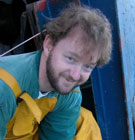Dr Bryce Stewart from our Department of Environment and Geography is a key figure in a visionary proposal to restrict fishing in a network of protection zones across the Firth of Clyde on the West coast of Scotland. The Firth is the largest and deepest area of coastal waters in the British Isles where once plentiful stocks of cod, haddock and plaice have almost completely collapsed as a result of overfishing.
Dr Stewart says without action, the area could be facing an ecosystem meltdown: “The problem with the Firth of Clyde is that all our eggs are now in one basket. It was once one of the most productive fishing areas in Europe, but now over 99 per cent of the commercial fisheries landings are for shellfish, such as prawns and scallops, rather than fish.
“This means the remaining fisheries are dependent on a very limited number of species.”
Climate change
The problem is compounded by the fact that the remaining shellfish are potentially vulnerable to disease. Climate change and ocean acidification are adding to the troubles.
In his role as Chair of the scientific board of the Sustainable Inshore Fisheries Trust (SIFT), Dr Stewart is at the centre of a major campaign, led by SIFT, to convince the Scottish Government that restricting fishing across the Firth of Clyde, could revive the ailing marine environment. Campaigners say restrictions could also improve the fortunes of the once buoyant commercial fishing fleet.
The Scottish Government is considering the SIFT proposals, known as the Firth of Clyde Regulating Order, with a decision due in 2016.
The challenge, says Dr Stewart, is convincing people that restricting fishing now will bring longer-term benefits in the future.
“Although we are proposing taking some areas away from the fishermen, if you give it enough time, you will actually start benefiting the fisheries and at the same time protect conservation interests.
“It’s like putting money in the bank and earning interest on it.
Marine nurseries
“We are asking the Scottish Government to protect certain parts of the Firth of Clyde from the dredgers and trawlers but allow some lower impact fishing like creeling and diving for scallops. There are also some highly protected areas where there should be no fishing at all. These areas would act as nurseries or replenishment zones.”
Crucially, thanks to former York PhD student Leigh Howarth, who was supervised by Dr Stewart and Dr Julie Hawkins, there is evidence that such an approach could work – and the evidence is drawn from the waters of the Firth of Clyde itself.
Scotland’s first and only fully protected marine reserve was created in 2008 in Lamlash Bay off the Isle of Arran, a scenic mountainous island which sits in the middle of the Firth of Clyde. The zone was set up after years of campaigning by the local Community of Arran Seabed Trust (COAST), who were dismayed about the effects of overfishing and seabed damage on their beautiful local coastline.
https://www.youtube.com/watch?v=Yh7uJVphezA
With the help of a plastic lunchbox filled with bait, our underwater cameras get close to life under the sea in Lamlash Bay, including an unexpected visitor...
No Take Zone
Research carried out by Leigh Howarth, working with staff and students at York, shows the island’s pioneering ‘No Take Zone’ is bringing the coastal waters around Arran back to life. Scallops and lobsters are thriving once again in the protected area and a mosaic of seaweeds and marine plant life is taking root on the recovering sea bed.
Now, the results from Arran, and a similar protected area around the Isle of Man, are informing the debate around the wider zoning proposals for the Firth of Clyde.
Commercial fishing
There is a groundswell of support for the Clyde plans, including a petition signed by over 7,000 local people. But some commercial fishing companies are opposed.
“I sympathise with the fishermen. We’re saying to them you might lose some money now but you will gain in the future. It’s a leap of faith,” says Dr Stewart.
“I think the best that SIFT can do is provide the science, based on the evidence from places like Arran. That’s my challenge. I need to use the science to convince the fishing industry this plan is in their long-term interests.”
The text of this article is licensed under a Creative Commons Licence. You're free to republish it, as long as you link back to this page and credit us.




